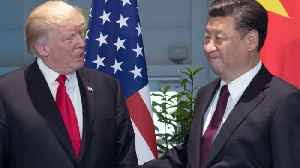Trump edges closer to China tariffs, appears to avert trade war

U.S. President Donald Trump signed a presidential memorandum on Thursday that could impose tariffs on up to $ 60 billion of imports from China, although his action was far removed from threats that could have ignited a global trade war.
Under the terms of the memorandum, Trump will target the Chinese imports only after a consultation period, a measure that will give industry lobbyists and legislators a chance to water down a proposed target list which runs to 1,300 products.
China will also have space to respond to Trump’s actions, reducing the risk of immediate dramatic retaliation from Beijing, and Trump struck an emollient tone as he started speaking. “I view them as a friend,” he said.
“We have spoken to China and we are in the middle of negotiations,” Trump said, adding that the loss of American jobs from unfair trade was one of the main reasons he had been elected in 2016.
The threatened tariffs as well as possible investment restrictions on China stem from the U.S. Trade Representative’s investigation of alleged misappropriation of U.S. intellectual property by Beijing.
U.S. officials say that probe, undertaken through Section 301 of the 1974 Trade Act, has found that China engages in unfair trade practices by forcing American investors to turn over key technologies to Chinese firms.
Washington will also pursue alleged breaches of intellectual property law by China through the World Trade Organization, a body that has repeatedly drawn the ire of the administration but which could provide a resolution that avoids a trade war.
Trump, who earlier this month announced steep tariffs on steel and aluminium imports to the United States, also wants the Chinese to take action that would lower the $ 375 billion goods trade deficit that the United States is running with China.
Global stocks sold off earlier on Thursday on the expectation of tough action from Trump and fears of a global trade war. They recovered somewhat after his announcement but fell again in late afternoon trading.
WILL CHINA ROCK THE BOAT?
The U.S. Trade Representative’s office will now present a list of Chinese products that could be targeted, primarily from the high-tech sector. There will then be a 60-day consultation period before definitive action is taken.
White House officials told a briefing ahead of the trade announcement that the administration was eyeing tariffs on $ 50 billion in Chinese goods. They said the figure was based on a calculation of the impact on the profits of U.S. companies that had been forced to hand over intellectual property as the price of doing business in China.
There was no explanation of the difference between that figure and Trump’s $ 60 billion.
“Many of these areas are those where China has sought to acquire advantage through the unfair acquisition and forced technology transfer from U.S. companies,” said Everett Eissenstat, deputy director of the National Economic Council.
In addition, Trump will also direct the U.S. Treasury to propose measures that could restrict Chinese investments in the United States, Eissenstat said.
China has threatened to target U.S. exports of agricultural commodities, in particular the $ 14 billion in exports of soybeans. Aircraft maker Boeing Co (BA.N) and machinery company Caterpillar Inc (CAT.N) could also be in Beijing’s sights.
“We urge the Trump administration to consider the impact these escalating tariff actions will have on farm country,” Farmers for Free Trade, an industry lobby group, said in a statement after the tariffs were announced.
Farm incomes were at their second-lowest levels since 2003 in inflation-adjusted terms in 2017, according to the Congressional Research Service. Many farming districts favoured Trump in the presidential election.
Despite threats of retaliation, China has been keen to portray itself as a defender of globalization, a message that was reinforced in a call between President Xi Jinping and French President Emmanuel Macron.
That said, there is a risk of a mounting cycle of retaliation. U.S. Trade Representative Robert Lighthizer warned on Wednesday that Washington would take “counter measures” if Beijing targeted U.S. agriculture.
The biggest risk to world trade over the longer term may not be a tit-for-tat trade war, but the breakdown of global supply chains that feed companies such as U.S. auto giant General Motors Co (GM.N) and Apple Inc (AAPL.O).
“Tensions are likely to escalate further, even without a full-scale trade war. This could disrupt global supply chains and damage investor sentiment,” said Dario Perkins, head of global macroeconomics research at TS Lombard, a London-based economic consultancy.
Trump’s steel and aluminium tariffs, which are tied to Section 232 of the 1962 Trade Expansion Act, go into effect on Friday. Canada and Mexico have been given initial exemptions from the 25 percent steel and 10 percent aluminium tariffs.
Lighthizer told U.S. lawmakers on Thursday that the European Union, along with Argentina, Australia, Brazil and South Korea, would also be exempted.
Additional reporting by Steve Holland, David Chance, David Lawder and Susan Heavey; Writing by David Chance; Editing by Doina Chiacu and Paul Simao



